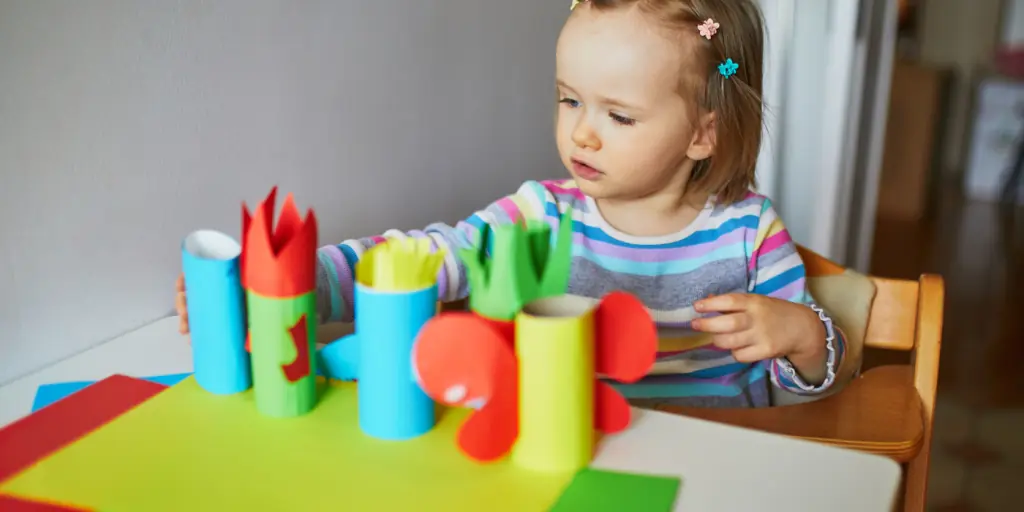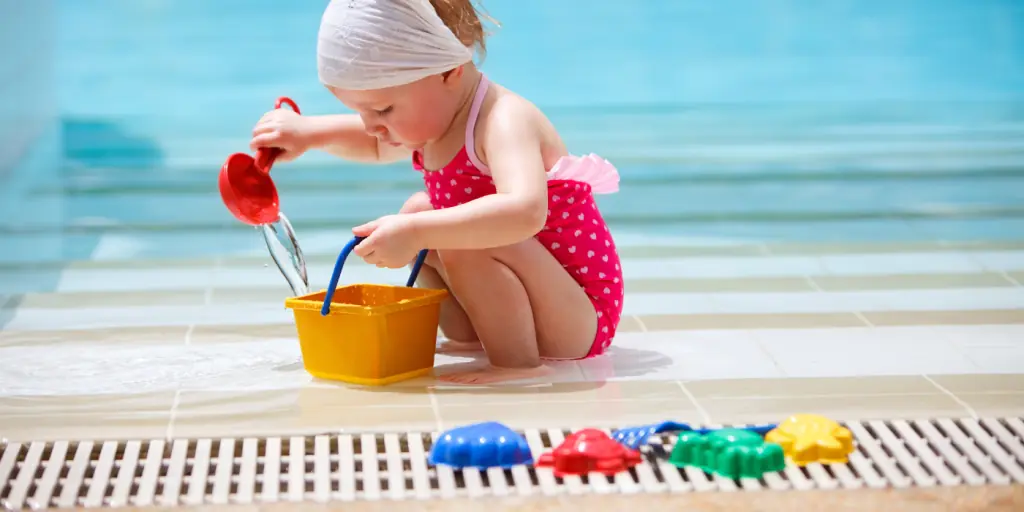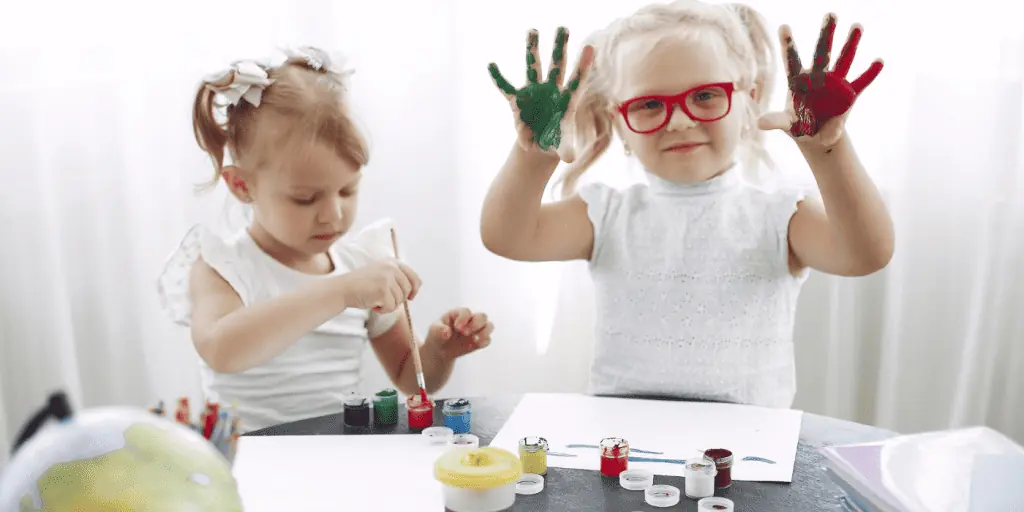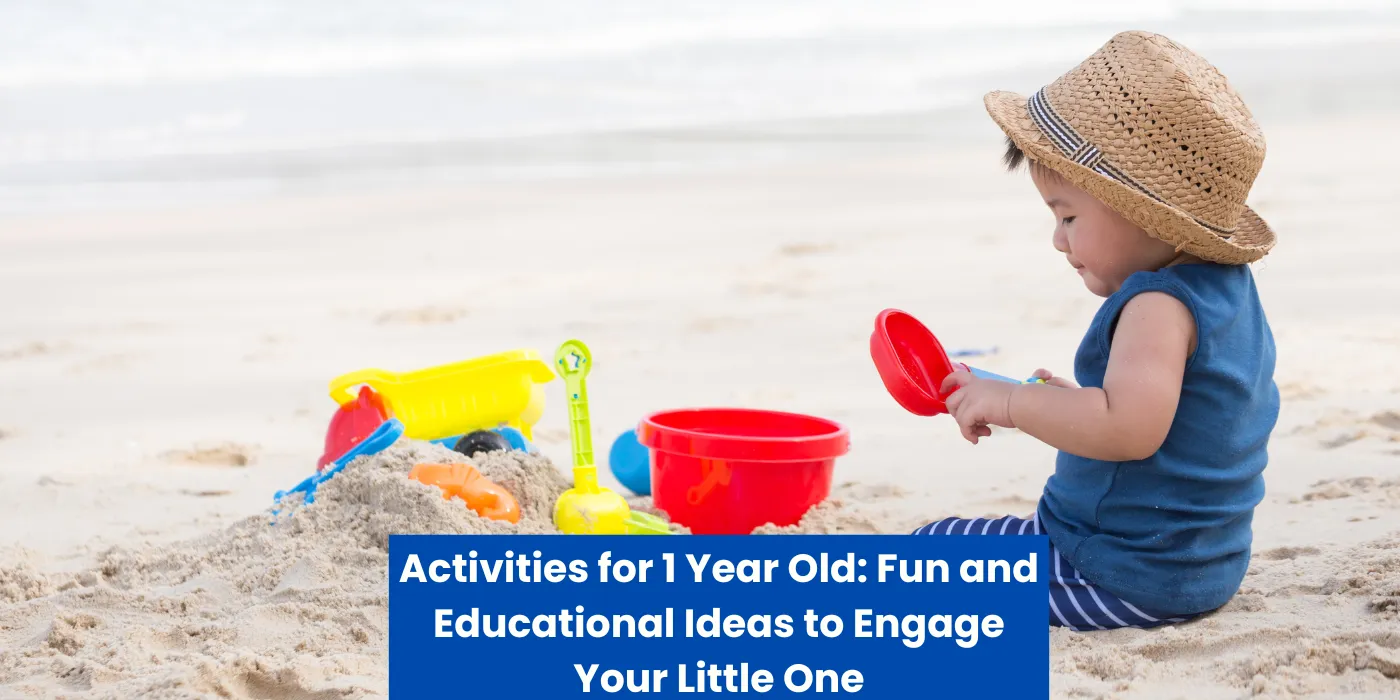Unleash your little one’s curiosity and creativity with our collection of fun and educational activities for 1-year-olds. Discover engaging ideas for kids activities designed to spark their imagination, support their development, and create cherished memories together!
As a parent, finding activities to keep your 1-year-old entertained and stimulated can be a challenge. At this young age, children are eager to explore the world around them, but they still have limited abilities and attention spans.
Fortunately, there are many fun and engaging activities and art projects that you can do with your little one to promote their development and keep them entertained.
From sensory play to fine motor activities, there are countless options to choose from. Sensory activities, such as exploring different textures and smells, can help your child develop their senses and cognitive skills.
Fine motor activities, like playing with blocks or finger painting, can help improve their hand-eye coordination and dexterity. It’s important to choose activities that are developmentally appropriate for your child’s age and abilities.
In this article, we will explore some of the best activities for 1-year-olds that can keep them entertained and promote their development.
Whether you’re looking for indoor or outdoor activities, low-prep or no-prep options, or activities that can be done with household items, we’ve got you covered. Let’s dive in!

Physical Activities
Outdoor Activities
Outdoor activities are an excellent way for 1-year-olds to get fresh air, exercise, and enjoy the world around them. By engaging in outdoor activities, your child can develop essential skills such as gross motor skills, hand-eye coordination, and balance.
Furthermore, spending time outdoors and learning fun exposes your child to new sensory experiences and promotes a healthy connection with nature. Here are some ideas for outdoor activities that will provide hours of fun and learning for your little one.
Walks in the Park or Neighborhood
Taking a walk in the park or around the neighborhood is a simple and effective way to introduce your child to the outdoors. As you walk, point out interesting sights, sounds, and smells, encouraging your child to observe their environment.
Walking also provides opportunities for your child to practice and improve their gross motor skills, balance, and coordination. To keep your walk engaging, you can also incorporate games such as ‘I Spy’ or encourage your child to collect leaves or rocks.
Sandbox and Playground Play
Playing in a sandbox or at a playground offers numerous opportunities for your 1-year-old to develop their gross and fine motor skills. Sand play encourages creativity, problem-solving, and sensory exploration. Provide toys such as buckets, shovels, and molds to enhance the experience.
Playgrounds, on the other hand, offer a variety of equipment that encourages climbing, swinging, and sliding, helping your child develop strength, coordination, and balance. Always ensure proper supervision to guarantee your child’s safety while playing.
Nature Scavenger Hunt
A nature scavenger hunt is a fun and engaging way to explore the outdoors with your child. Create a simple list of items to find, such as rocks, leaves, flowers, or sticks, and encourage your child to search for them.
This activity promotes observation skills, problem-solving, and a love for nature. Scavenger hunts can be adapted to different environments and seasons, providing endless opportunities for exploration and learning.
Ball and Bubble Play
Playing with balls or bubbles is a very fun game, and easy outdoor activity for 1-year-olds. Ball play helps develop gross motor skills, hand-eye coordination, and social skills such as taking turns. Start with larger, softer balls that are easier for your child to grasp and manipulate.
As they become more skilled, introduce smaller balls or practice rolling, bouncing, and tossing. Bubbles provide a magical and engaging experience that encourages your child to reach, grasp, and chase, promoting physical activity and coordination.
Bike Rides and Wagon Rides
Taking your child on a bike ride or wagon ride is a delightful and fun way to explore the outdoors together. Riding in a bike seat or wagon allows your child to observe their surroundings while experiencing the sensation of movement.
Be sure to prioritize safety by using appropriate equipment such as helmets and securely fastened seats. Bike and wagon rides offer a fun and engaging way for your child to enjoy the outdoors while developing their observation skills and an appreciation for their environment.
Outdoor activities for 1-year-olds provide numerous opportunities for growth, development, and exploration. By incorporating a variety of activities, you can ensure your child stays active, engaged, and connected with the world around them.

Indoor Activities
When it’s too cold or rainy for little kids to go outside, there are still plenty of physical activities that 1-year-olds can do indoors. Here are some ideas:
- Build a fort with pillows and blankets.
- Play with a balloon or beach ball.
- Have a dance party.
- Play with a sensory bin filled with items like rice or pasta.
- Do an obstacle course using pillows, cushions, and other household items.
Remember, it’s important to supervise 1-year-olds during physical activities and make sure they are safe at all times. It’s also important to let them explore and have fun while being active.
Sensory Activities
One-year-olds are curious and love to explore their surroundings. Sensory activities are a great way to engage their senses and promote their development. Here are some fun and easy sensory activities for your little one.
Top pick

Made By Me-Explore & Create Sensory Bin
These vibrant sensory kits come in a range of themes and include everything you need to create an exciting sensory experience for your little one- even a case to pack everything back in to!
Bestseller

Step2 Rain Showers Splash Pond Water Table
Complete with accessories, this water table provides ample opportunity for sensory fun as well as STEM learning. A firm favourite for toddlers!
Mess Free Sensory Fun

Learning Resources Sensory Fidget Tubes
Sensory fun needn’t be messy! These fidget tubes are perfect for on the go sensory pay, stimulating your little ones senses
Water Play
Water play is an engaging and sensory-rich activity that can provide countless hours of enjoyment and learning for young children. Not only does it encourage the development of fine and gross motor skills, but it also sparks curiosity and creativity while keeping them entertained.
There are numerous ways to expand on the basic concept of water play to create a more immersive and stimulating experience for your child.
Introducing Bubbles
Adding bubbles to the water can transform a simple water play activity into a magical experience. Use a gentle, child-safe bubble bath or dish soap to create a tub of bubbly water.
Children will love the tactile sensation of the bubbles and can have fun trying to catch and pop them. This addition also encourages hand-eye coordination and sensory exploration.
Pouring and Scooping
Incorporating cups, spoons, and other containers into your water play setup will allow your child to practice their pouring and scooping skills. This is an excellent opportunity to work on their hand-eye coordination and fine motor skills, as they learn to control the movement of water between different containers.
You can also introduce various sized cups and spoons, which can help them develop an understanding of volume and measurement.
Colorful Water Play
Adding food coloring to the water can create a visually captivating experience for your child. Use a few drops of different colors to make the water vibrant and exciting. This can help your child learn about color mixing and the formation of new colors when different hues are combined.
For an added challenge, you can encourage them to try and create specific colors by mixing the primary colors (red, blue, and yellow) in different proportions.
Floating and Sinking Objects
Introduce various objects into the water play environment to help your child explore the concepts of floating and sinking. Provide a range of items, such as plastic toys, rubber ducks, foam shapes, or even natural materials like leaves or sticks.
Encourage your child to observe and compare how different objects interact with the water, and discuss why some items float while others sink. This activity can spark their interest in basic scientific concepts and encourage problem-solving skills.
Themed Water Play
Create themed water play experiences to further engage your child’s imagination and curiosity. For example, set up a small marine environment with plastic fish, boats, and shells, or create a car wash station with toy cars, sponges, and brushes.
Themed water play can also be an opportunity to teach your child about different environments, animals, or occupations.
Temperature Exploration
Introduce your child to the concept of temperature by providing water at different temperatures. Fill separate containers with warm and cold water and let your child explore the differences.
This can help them develop an understanding of hot and cold sensations while promoting sensory exploration.
Water play is a versatile activity that can be adapted to suit your child’s interests, age, and abilities. By incorporating various elements and challenges, you can create a stimulating and educational experience that will keep your little one entertained while supporting their overall development.

Sensory Bins
Sensory bins are a fantastic way to provide your child with a rich, tactile learning experience that stimulates their curiosity and creativity. These containers are filled with various materials that engage your child’s sense of touch, allowing them to explore different textures, shapes, and sizes.
Sensory bins can be tailored to suit your child’s interests and developmental stage, making them a versatile and adaptable learning tool. Here are some ideas for creating sensory bins that will provide hours of fun and various learning activities for your little one.
Rice or Pasta Sensory Bin
A bin filled with rice or pasta offers a simple yet effective sensory experience. Choose from a variety of grains, such as rice, pasta shapes, or even lentils, to create a diverse and engaging texture for your child to explore.
Provide cups, spoons, and other scooping tools to encourage fine motor skill development as they practice pouring and transferring the materials between containers. For an added element of fun, you can dye the rice or pasta with food coloring to create a vibrant and visually stimulating environment.
Sand Sensory Bin
A sand-filled bin brings the excitement of the beach right to your home. Fill a container with play sand and provide small toys, such as shovels, buckets, and plastic molds, for digging and burying.
This sensory bin encourages imaginative play as your child creates sandcastles, buries treasures, and uncovers hidden objects. Sand play also promotes the development of hand-eye coordination and fine motor skills, as your child manipulates the sand and toys.
Water Beads Sensory Bin
Water beads are an innovative and unique material for sensory play. These small, colorful beads expand when soaked in water, creating a smooth, slippery texture that is fascinating to explore.
Fill a bin with water beads and let your child plunge their hands in to experience the intriguing sensation. You can also provide tools such as tweezers or scoops to encourage fine motor skill development and hand-eye coordination.
Water beads are available in various colors and sizes, allowing you to create a visually engaging sensory bin that captures your child’s interest.
Nature Sensory Bin
Bring the outdoors inside with a nature-themed sensory bin. Fill a container with materials such as leaves, twigs, pinecones, rocks, and other natural items.
This sensory bin encourages your child to explore the textures and shapes of the natural world while promoting their understanding of the environment. You can also provide magnifying glasses, tongs, or other tools for examining and manipulating the materials.
Themed Sensory Bins
Create sensory bins based on your child’s interests or favorite themes. For example, you can fill a bin with toy cars and shredded construction paper to simulate a race track or construction site.
Alternatively, create an ocean-themed bin with blue water, seashells, and plastic sea creatures. Themed sensory bins help to spark your child’s imagination and this fun activity can be adapted to suit various topics, such as seasons, holidays, or educational themes.
Sensory bins are an engaging and educational tool that can be easily customized to suit your child’s needs and interests. By providing a diverse range of materials and textures, you can create stimulating and enjoyable learning experiences that promote the development of essential skills and a lifelong love of exploration.
Messy Play
Messy play is an excellent way to engage your child’s senses, promote their creativity, and encourage the development of essential skills such as hand-eye coordination and fine motor skills.
This type of play allows your child to explore different textures, colors, and materials in a safe and controlled environment. By embracing the mess, you create an opportunity for your child to learn through hands-on experiences, fostering their curiosity and imagination.
Here are some ideas for messy play activities that will provide hours of fun and learning for your 1-year-old.
Shaving Cream Exploration
Filling a tray with shaving cream offers a sensory-rich experience that your child can enjoy with their hands. The smooth, foamy texture of the shaving cream provides a unique sensation that encourages tactile exploration.
Encourage your child to squish, smear, and sculpt the shaving cream, experimenting with different shapes and patterns. You can also add a few drops of food coloring to create a vibrant and visually engaging activity.
As your child manipulates the shaving cream, they develop essential fine motor skills and hand-eye coordination.
Finger Painting Fun
Finger painting is a classic art activity that allows your child to express their creativity while developing fine motor skills. Provide non-toxic, washable finger paints and large sheets of paper or a plastic tablecloth for a canvas.
Encourage your child to explore free play with the different colors and textures of the paint as they create their masterpiece. Finger painting is not only a fun and messy play activity but also promotes hand-eye coordination, color recognition, and early artistic expression.
Cooked Spaghetti Sensory Play
A bin filled with cooked spaghetti offers a unique and engaging sensory experience. The soft, slippery texture of the noodles encourages your child to squish and manipulate the pasta with their hands.
As they play, they develop fine motor skills and hand-eye coordination. You can enhance the experience by adding a few drops of food coloring to the spaghetti, creating a visually stimulating environment.
Provide utensils such as spoons, tongs, or cups to encourage pouring and scooping, further promoting the development of essential skills.
Edible Sensory Play
For younger children who may still be prone to putting things in their mouths, creating edible sensory play experiences can provide a safe and engaging fun activities.
Fill a tray or bin with materials such as yogurt, applesauce, or pudding, and encourage your child to explore the different textures with their hands. Or even play dough can be so much fun and help with real life skills.
You can also provide edible finger paints made from food ingredients such as cornstarch and water. Edible sensory play offers a fun and safe way for your child to engage in messy play while also promoting fine motor skills and hand-eye coordination.
Outdoor Messy Play
Taking messy play outdoors can provide a whole new range of experiences for your child. Set up a mud kitchen using old pots, pans, and utensils, and let your child explore the different textures and properties of mud.
Alternatively, create a large-scale painting activity using washable paints and a sheet hung on a fence or laid on the ground. Outdoor messy play not only provides a fun and engaging experience but also encourages your child to connect with nature and the environment.
Messy play is a valuable learning tool that encourages your child’s creativity, sensory exploration, and skill development. By embracing the mess and providing a range of engaging activities, you can create a stimulating and enjoyable learning environment for your 1-year-old.

Language and Cognitive Activities
Language and cognitive development are crucial for a 1-year-old’s growth and learning. Here are some activities that can help your little one develop these skills:
Reading Books
Reading books to your 1-year-old can help develop their cognitive and language skills. Choose books with bright colors and simple words. Point to the pictures and name them. Encourage your child to point to the pictures too. This activity can help develop their vocabulary and comprehension skills.
Playing with Blocks
Playing with blocks can help develop your child’s cognitive and problem-solving skills. Encourage your child to stack the blocks and knock them down.
Count the blocks as you stack them. Use words like “up” and “down” to describe the blocks’ movements. This activity can help develop your child’s understanding of spatial relationships and cause-and-effect.
Puzzles
Puzzles can help develop your child’s cognitive and fine motor skills. Choose puzzles with large pieces that are easy for your child to handle.
Encourage your child to match the pieces to the correct spot. Use words like “fit” and “match” to describe the process. This activity can help develop your child’s problem-solving skills and hand-eye coordination.
Social and Emotional Activities
As toddlers grow and develop, it’s important to help them build their social and emotional skills. Here are some activities that can help:
Playing Peek-a-Boo
Peek-a-boo is a classic game that can help toddlers develop their social and emotional skills. It teaches them about object permanence and helps them understand that things still exist even when they can’t see them. It can also help them learn about emotions, as kids learn when they watch the different facial expressions of the person playing with them.
Playing with Dolls and Stuffed Animals
Playing with dolls and stuffed animals can help toddlers learn about emotions and social interactions. They can practice taking care of their “baby” or “animal” and learn about empathy and nurturing. They can also practice social interactions by having tea parties or playing pretend games with their toys.
Singing Songs
Singing songs is a great way to help toddlers develop their social and emotional skills. They can learn about emotions through the lyrics and melody of the song. They can also practice social interactions by singing with others or performing for an audience.
Overall, social and emotional activities are important for toddlers to help them develop their skills and build relationships with others.
What are good activities for 1-year-olds?
There are numerous good activities for 1-year-olds that can help them develop fine motor skills, gross motor skills, and cognitive abilities. Some examples include sensory play, stacking blocks, shape sorting, and finger painting.
What cool things can I teach my 1 year old?
You can teach your 1-year-old a variety of cool things, such as identifying colors, shapes, and animals, developing hand-eye coordination through activities like playing with toy cars or balls, and exploring different textures with sensory play.
How many words should a 1 year old say?
A 1-year or 2 year old-old typically starts to say a few words, around 3 to 5 words or even more. However, it’s important to remember that each child develops at their own pace, and some may be more advanced in their language skills than others.
What outdoor activities for 1 year old?
Outdoor activities for a 1-year-old can include playing in the sandbox with sand toys, exploring nature with a nature walk or scavenger hunt, and engaging in water play with a small pool or water table. These activities help develop gross motor skills and hand-eye coordination.
What are good fun activities for 2 year olds?
Good activities for 2-year-olds include imaginative play, such toddler activities such as dress-up or pretend play, problem-solving activities like simple puzzles or board games, and educational activities that teach new skills, like counting or identifying letters. These activities can help develop cognitive and motor skills, as well as foster social development.





